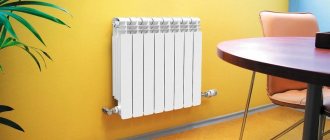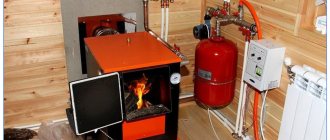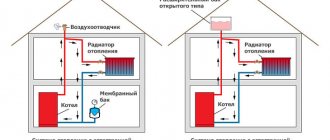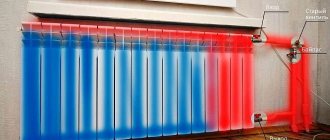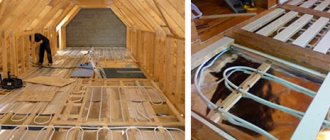“Batteries hardly heat up” - this phrase, or its variants, can often be heard in the cold season. Sometimes such assessments can be purely subjective. But, usually, people complain about problems with the heating system. More often, heating problems occur during periods of severe cold weather and (as a consequence) the most intense operating conditions of heating systems.
Of course, breakdowns of the heating system do occur, but much less often if preparation for the heating season is carried out on time and efficiently. Malfunctions occur when the load on the mechanism or system is maximum. In this case, breakdowns occur more often. However, in addition to emergency failures of the heating system, batteries can become cold for a number of other reasons.
Having reliable information about the causes of cold radiators is useful for both apartment owners and owners of private houses. You should also be aware of the possibilities of optimizing the heating system to increase the efficiency and economy of its operation.
Here is a list of reasons why cold batteries appear in a house or apartment:
Incorrect connections in the heating system
The correct design and installation of the heating system is the basis for the efficiency of space heating and optimization of heat consumption. A common mistake is incorrect installation of the bypass. It should be noted that installing the tap directly on the bypass is prohibited. With this installation, it is possible to shut off the circulation throughout the entire riser if the valves on the battery and the bypass are closed at the same time. This is especially true in an apartment building and with a single-pipe connection scheme.
The number of sections that make up the heating radiator is too large compared to the design one. If necessary, you can connect the radiator “diagonally” or install a “flow extender” on such a radiator. You can make such a bypass - flow extender yourself or purchase a ready-made one.
With a multi-circuit system, balancing valves should be provided during installation in the shorter arm of the system. With such taps you can even out the temperature balance in different parts of the heating system.
Are the valves working?
Typically, each radiator has two valves - on the supply and return. With their help, you can regulate the flow rate of water or coolant. If one or both valves fail, flow capacity may be reduced.
You can check the operation of the valves experimentally. Try covering or opening them. If after 5-15 minutes (depending on the type of battery) the temperature of the radiator surface changes, everything is in order. If not, there is a problem with one or two valves.
To determine the cause, you will have to shut off the riser and drain the water . After this, disconnect the heating radiator and inspect the valves. Check if they block the channel. If one or both fail, replacement is necessary.
Airing the heating system
The most common cause of cold radiators in houses and apartments is air getting into the heating system circuit. As a result of the presence of minor air bubbles, a bubble is formed during the circulation process that blocks the flow. The provided air vent is not always effective.
If the heating system riser is airy, which is understandable when cooling several radiators, you should contact maintenance and call a plumber.
If one of the batteries becomes airy (when the supply pipes are hot and the radiator or part of it is cold), you can bleed off the accumulated air yourself. Modern heating radiators are usually equipped with a Mayevsky tap. To bleed air, such a tap must be opened slightly until water appears. Videos and printed instructions are available on the Internet.
Air is the enemy
If the battery is hot at the bottom and cold at the top, airiness may be the cause. Especially with a bottom or saddle connection. If a coolant or low-quality water circulates through the heating system, it can react with metals and plastics.
This releases air, hydrogen or other gas. It accumulates at the top of the radiator. Air or other gas is blocking the flow of water or coolant. The heat output of the radiator decreases and it cools down quickly.
The solution to the problem is simple - you need to bleed the air from the heating battery. The Mayevsky crane is used for this purpose. It is located at the end of the upper part of the radiator instead of a plug. To remove gas:
- Place a small container (glass, cup) under the lower part of the Mayevsky tap;
- Start unscrewing the tap until you hear a characteristic hissing sound;
- First, air will come out of the hole, then its mixture with water;
- When clean water or coolant flows out of the hole, turn off the Mayevsky tap.
Bleeding air from the heating radiator through the Mayevsky tap.
Advice
If the radiator does not have a Mayevsky tap, install it. For this:
- Close the supply and return valves.
- Unscrew the top plug.
- Select a Mayevsky tap that is suitable in diameter and thread pitch.
- Install it in place of the plug and open the valves.
- Wait 3-5 minutes and release the remaining air.
Clogged heating system riser
A clogged heating system riser in an apartment building is determined by the cooling of heating radiators in several apartments. Typically, such radiators can be located vertically one below the other, depending on the configuration of the specific heating system. Usually, with such a breakdown, the upper floors receive enough heat, and the lower floors freeze. This is especially noticeable when there is a strong minus on the street.
The reasons that lead to clogging of the riser are usually laid down at the installation stage. A decrease in the diameter of the riser pipe by 0.25 compared to the design one leads to clogging with oxides and debris after just a few years.
Removing such a clogged system riser usually requires the work of a qualified team of plumbers. Often, such repairs also require the consent of other residents, including apartments that are not directly affected by the emergency.
What to do if the radiators in the apartment are cold and the riser is hot?
Regardless of whether the cold heating equipment is only in the riser or in the entire entrance, and possibly throughout the house, you must seek help from qualified specialists. In the case of an apartment building, this is a plumber of the company that is responsible for the heating supply of the house.
Cold batteries with a hot riser may be due to a clogged system or the formation of an air lock in it. An important factor is the pressure in the wiring. In some cases, the problem of low coolant flow is relevant. It is possible to independently find out the reason for the low efficiency of heating elements. But only a true professional in his field will clearly answer any questions that arise and competently fix the breakdown. This video will help you to make your radiators heat better:
One of the batteries is clogged
A clogged heating system battery can be easily identified by a significant decrease or absence of heating. The entire battery or only part of it may not “heat.” In this case, the riser pipe is clearly warm and there is no air in the system.
Even a new or recently repaired radiator can clog. Oxide, scale and other process debris are especially common in new or recently renovated systems.
Flushing the radiator is quite easy, especially if two American-type taps are installed. Such taps allow you to dismantle the radiator without draining the water from the system. The taps are turned off - the radiator is disconnected and removed, then the radiator is washed manually and mounted in place. This way you can flush any modern radiator. Of course, if it is equipped with two taps (inlet and outlet).
Radiators of the old type, cast iron, are also easy to clean, but have more weight. The worst situation is with old stamped (corrugated) metal radiators. Contact welding in such radiators is highly susceptible to corrosion and a leak usually occurs after washing. Therefore, it is better to replace this radiator immediately.
Causes of heating problems ↑
Cold radiator compartments indicate that they do not contain coolant - hot water supplied to the apartment through a central system. The roots of this phenomenon are known, so home craftsmen can only follow the advice and correct the problems.
In order to most accurately identify the cause of a cold heat exchanger, it is recommended to visit your neighbors on the floor above and below and ask how things are going with them. If the situation is similar in other apartments, then most likely the culprits are faulty or closed valves in the basement, or clogged pipes and risers.
Radiators should not only decorate, but also heat the room
If there are several risers in the apartment and all the radiators do not warm up well enough, then the low temperature of the coolant should be blamed for this phenomenon. In this case, there will be similar complaints in neighboring apartments, which should be addressed to the housing department.
The situation is sadder if everything is fine in the neighboring apartments, and the batteries powered by another riser heat up without problems. In this situation, most likely, the flow of hot water is hampered by air pockets accumulating in the radiator, or blockages in the pipes or battery compartments.
Three way valve
To balance the circulation of water flow in the heating system, a three-way valve is usually installed at the junction of the radiator and the bypass. Such a faucet may have the following provisions for adjusting water movement:
- only via bypass;
- only through the radiator;
- through the radiator and through the bypass;
- everything is blocked.
If the local heat transfer in such a radiator has decreased, then the three-way valve should be slightly turned in opposite directions. The scale accumulation will be destroyed and normal operation of the radiator and bypass will be restored.
If there is a leak from under the rod, remove the top nut and replace the waterproofing gasket.
Over time, the three-way valve “sticks” while in one position, and the accumulation of scale blocks the water circulation. In this case, it is advisable to replace the damaged three-way valve, since restoration will not be able to extend its service life.
Wrong radiator?
Some radiators have plugs installed. They block one channel between sections, directing the flow of coolant or water in the desired direction. Such heating batteries must be installed according to the rules, in accordance with the type of connection.
For some connection types, a plug is required. With its help, you can evenly distribute water or coolant throughout the entire volume of the heating device. In others, its presence will only interfere - the riser pipes will be hot and the battery will be cold.
The plug may cause air locks in one or more sections. It can interfere with the removal of air through the Mayevsky tap if installed in the upper part of the heating radiator manifold.
You can determine whether there is a plug using the documentation for the heating device or by visual inspection. Let's look at the issue in more detail, with illustrations.
Top connection
With this type of connection, the radiator must have a plug between sections 1 and 2 in the upper part. If the top of the radiator is hot and the bottom is cold, it is missing. You need to install it.
Bottom connection
Such batteries should not have a plug. If one of the sections is much warmer than the others, then it is installed at the bottom of the hottest section. It is necessary to remove the radiator and remove the plug.
Side connection
If the first section of the radiator is hot, and the rest are cold or slightly warm, a plug is installed between sections 1 and 2. If all sections are hot, and the last one is cold, the hole between the last and penultimate sections is blocked. We need to remove it.
Important
With a lateral connection, the temperature of the radiator sections drops depending on the distance to the pipes. There is no way to avoid this. The temperature difference is noticeable with a large number of sections.
Diagonal connection with bottom feed
With this connection, there should be no plug in the heating radiator. If available, there are two options:
- If the first section is significantly hotter than the others, the plug is located at the bottom, between the 1st and 2nd;
- If the last section is warmer, it is at the top between the last and penultimate ones.
Diagonal connection with top feed
This type of connection can work with a plug if it is installed between sections 1 and 2. If it is at the bottom, between the last and penultimate ones, then all sections will be cold. Only the last one will remain hot.
The riser is blocked
The reasons when the riser in a multi-storey building is blocked affect all residents who live in the “disaster area”. In fact, unauthorized blocking of the riser can be done by one of the residents out of ignorance. In any case, with such an overlap, there is a need for the intervention of regular plumbers to clarify and fix the problem. Of course, this causes the batteries to become cold.
More frequent causes of a blocked riser occur after any repairs have been carried out that required such a blocking. Each riser of a multi-apartment multi-storey building is equipped with shut-off valves at the top and bottom. Carrying out repairs in which both the upper and lower taps are closed requires special permission.
At the end of the repair, the specialists could simply forget to turn the riser back on to normal mode. If, in the user’s opinion, the riser is blocked, then you should contact the relevant organization and find out the details. You should not attempt to restore the riser operation without permission.
Fixing problems
Diagram of water supply to batteries
Repairing a sewer riser yourself is quite problematic. Especially if you don’t know anything about this kind of work. In addition, if any malfunctions are detected, you should immediately contact the relevant organizations. That is, to those who are responsible for your home, or directly to the organization that is responsible for heating.
If they tell you that they know nothing, the reasons are incomprehensible to them, then you have the right to express everything you think about them. Remember, they are obliged to resolve such issues at the request of the client. After all, it turns out that the heating season begins, you supposedly receive your heat (although for one reason or another it does not reach the water supply risers), and therefore a corresponding debt for utilities accumulates. In other words, although there is no heat, you have to pay for it.
In this regard, are you really obliged to wait several days until the plumbers come, figure out the reasons, and take certain actions? No, you must demand immediate repairs.
Causes and their elimination
Heat map of a radiator that is most likely bloated
Before the relevant specialists come to you to resolve the current situation, it would be a good idea to obtain additional information about the operation of the water supply riser and sewer riser in order to provide the specialists with the relevant data. Based on them, perhaps they will be able to find the reason for the lack of heat in your home much faster.
Therefore check:
- How well do the batteries warm up on other water supply risers located in your apartment?
- How well the batteries warm up on your own riser, but only those of the neighbors below;
- How well the radiators of the neighbors in the adjacent entrances heat.
Now you can consider each of the situations in more detail, which will allow you to determine the causes of the malfunctions, as well as find a way to solve the problem.
- When the radiators in other rooms of your apartment heat normally, and the apartments below and above are heated well, it means that the valves at the inlet or outlet of the radiator may be faulty, which does not heat well. There is also a possibility of blockage in the outlet and inlet pipes. Finally, don't rule out that the battery itself is clogged.
- If the battery does not heat well, and neighbors below and above have problems on the same riser, then the reason is the blockage or malfunction of the corresponding valves located in the basement. Another option is clogged return or direct riser pipes.
- It also happens that water supply risers receive insufficient flow of water, that is, coolant, which is why heating is not carried out completely throughout the house or in a separate entrance. Consequently, an increase in pressure is already necessary here.
Air jams
Quite often, heating risers and sewer risers cannot provide heat to your home because an air lock has formed. It is formed there quite naturally when the water is heated and the system is suddenly filled with coolant. If there is a bleeder valve on the system, it will not be difficult to determine the presence of an air lock. On modern batteries, this valve is on top and works autonomously, releasing excess air from time to time.
In the absence of automation, a manual valve is provided, which is unscrewed and kept open until water flows.
Alas, older models are not equipped with taps. But there is a plug there, which will not be so difficult to remove. Just be sure to place some kind of container under it to prevent water from spilling onto the floor. Do not unscrew the plug completely, but only unscrew it until a hissing sound appears. As soon as a similar sound begins to come out of the system, put the instrument aside and wait until the air comes out and water starts flowing. When water has seeped out, carefully tighten the cap, but do not remove the basin for a couple of hours in case the water continues to drip for a while.
Replacing radiators
If the reason for your lack of heating is not that the water supply risers are faulty or the sewer riser has died, and flushing the system did not give the expected result, you will simply have to change the radiators.
It is important to consider what kind of room you are choosing batteries for. For example, for a plumbing unit, an excellent solution would be a stainless steel product or a chrome-plated model. Consider the quality of the paint and its ability to function in high humidity conditions. It is not recommended to choose aluminum radiators for those who live above the eighth floor. This is due to the low operating pressure of such batteries. Plus, there is one more drawback - the internal surfaces of aluminum radiators rust over time, and therefore they are not suitable for long-term service.
For bathrooms, radiators are produced equipped with special hangers. They will heat the room and also dry your laundry if necessary. Let’s not forget about design solutions that can easily become a real highlight of your interior, while performing their assigned functions.
As you can see, there are many reasons why the battery remains or becomes cold, although the riser itself is hot. In fact, you can determine exactly why such a problem arose on your own.
Just remember, such issues must be resolved by the relevant organizations and specialists. They are responsible for the functioning and vital activity of all systems in an apartment building, and therefore they should be addressed first. Why waste your energy, nerves, money and time when there are people whose task is to eliminate such malfunctions.
Clogged water filter of the heating system
Sometimes there is an arbitrary decrease in the temperature of the “last” battery in the row. Then it is possible to cascade shutdown of other batteries in front of it. Typically, the reason for such an “abnormal” decrease in temperature is the filters of the heating system. This filter must be removed and cleaned thoroughly. During the first start-up, there may be debris in the water that is pumped into the heating system. To prevent this debris from entering the heating boiler heat exchanger, a filter is installed on the return pipe in front of the boiler. Usually one such filter is installed, but sometimes you can see several installed almost in front of each battery. This setup doesn't make any sense. After cleaning, the radiators in the house will no longer be cold.
Popular reasons
In almost all radiators, the temperature at the bottom is slightly lower than at the top. This depends on the high level of heat transfer. In this case, the water cools down before leaving the battery. With a small temperature difference, there is no cause for concern. A slight deviation is quite normal. But if you notice that the lower part of the radiator is barely warm or completely cold, then you should find out the reason and take measures to eliminate the problem.
- If you connect the radiator yourself, you can confuse the return and supply pipes. Also, if you use the services of an unqualified master, the following situation may arise. With such violations, the heating system is disrupted and the temperature at the bottom of the radiator drops.
- Low water circulation speed inside the radiator. This problem has a bad effect on battery performance. Due to the low speed, the temperature cools down before leaving the radiator. There can be many reasons for this speed. It needs to be identified and eliminated immediately.
Heating system check valve
A problem with cooling the last battery may occur after installing a check valve. In this case, you should dismantle the valve and remove the spring located inside it. The check valve is obviously designed for a higher pressure of water circulating in the system.
Maybe the neighbors are to blame?
It may sound trivial, but first make sure that you have hot water in your home, whether the tap is open for it to flow, or the riser is closed due to plumbing work in the basement. Don’t be too lazy to run through your neighbors on the upper floors. In the event of unprofessional repairs, some of them will have a comfortable radiator temperature, but all the residents below the riser will not receive heat and will be cold.
You have every right to come in like a neighbor with the question “the batteries are not heating: what to do”, and at the same time check their heating temperature. If you find a battery that is warmer than yours, then the problem that has arisen may simply result from the incorrect installation of the valves at your neighbor’s. Your further actions will depend on the situation; perhaps the shut-off valves, which deprived other neighbors of comfort, will be removed without a scandal. Or call your housing and communal services structure and, with the help of the administration, restore civil justice.
Balancing the heating system
Uneven heating across sections of the system should be eliminated by balancing the input in each battery. Typically, the location of the heating radiators further away from the boiler requires a greater flow of heated water when circulating. Such balancing should be done using existing taps and possible adjustment of bypasses. This is especially true if the last radiator in the house is cold.
To “finely” balance the heat transfer of each individual radiator, it is useful to remember the possibility of using a “flow extender”. This does not exclude the possibility of adjustment using three-way valves.
When installing a heated towel rail, it is necessary to take into account that it has less resistance to the circulating flow. Consequently, the heat consumption will be greater than in the batteries next to it.
Reasons for the battery not heating up
Air locks are the main reason for insufficient or uneven heating of radiators, but there are other reasons for this unpleasant phenomenon. These include :
- Poor circulation of coolant through the system pipes.
- Incorrect battery connection (for example, when the supply is connected to the bottom hole and the return to the top).
- Clogged inside the pipes and the battery itself.
Let's consider each possible option in more detail.
Circulation pump and coolant
It is not recommended to install a circulation pump near the last battery. This, of course, will allow this battery to warm up, but the heating of all the others will decrease significantly. In addition, when the hot water supply (DHW) is turned on, such a pump will still work.
If all elements of the heating system are in working order, you should pay attention to the coolant in the heating system . Typically, the coolant has a higher viscosity than water. Of course, there are certain reasons for using coolant in a heating system: for example, when installing in a country house. When using coolant with antifreeze, the system will not suffer from freezing.
It is recommended to change the coolant to distilled water, which will reduce the load on the circulation pump and the durability of the system as a whole.
An unbalanced system stops working
Also, the main and main reason why there is a cold heating riser in an apartment is mass construction, when the main task was to build as much cheap housing as possible in the shortest possible time. It’s not that the walls didn’t retain heat, which is why the room is cold when the radiators are hot, and people didn’t think about saving heat, because it used to be cheap. But people tend to freeze, they think about how to insulate a cold wall in an apartment and buy more and more radiators for their apartments, which are installed for them by people who are far from the correct installation of heating equipment. The time has come when the equipment of boiler rooms and in-house systems simply can no longer cope with the load. Their work is ineffective.
Battery Replacement
If the risers are in good condition, and flushing the battery does not produce results, it is recommended to replace it. When choosing this heating element, you should follow some recommendations. Namely:
- For rooms with high humidity, radiators made of stainless steel or with a chrome surface are suitable.
- There are radiators with heated towel rails especially for bathrooms.
- An aluminum radiator can be used by those who live below the 7th floor. This is due to its low operating pressure. From the inside it quickly becomes covered with rust, so its service life is no more than 10 years.
- Cast iron batteries can only be found in old houses. This metal has low thermal conductivity, so it contributes to low heating of the room.
- Steel radiators are characterized by low cost and high heat transfer. Their service life is 20-25 years.
There are many types of batteries, from which you can choose the best option for yourself.
Removing the old radiator
To remove the old battery you need to:
- Remove the lock nut on the lower and upper connections using a wrench.
- Use a level to determine the location of the intended pipe cut.
- Cut the pipes according to the existing marks and remove all brackets.
- If necessary, increase or cut the thread if it does not match the new radiator.
Installation of a new battery
If removing the old element yourself is problematic, then installing a new battery is quite labor-intensive and responsible, and mistakes can result in an emergency in the heating system. Therefore, this process should be done by professionals.
What can you do for a cold battery?
Clear a blockage in the radiator
In this case, washing with water under pressure will help. In order to easily remove the radiator during the heating season, a bypass must be installed. But it is better to resort to the services of a plumber, who will clean the radiator tank of sludge with a special chemical composition.
Convert a one-pipe system
Nothing can be changed in the single-pipe system itself. All that remains is to install a two-pipe water heating system.
In case of incorrect connection, it is necessary to redo the circuit
It is important! Of the three types of battery connections - bottom, side and diagonal - the most optimal option is the diagonal scheme.
In the event of a connection error, a clear sign is uneven heating of the sections and their parts, for example, the lower part of the battery does not heat. The sections closest to the connection point will be warm, the rest will be almost cold. With a side connection for a multi-section radiator, the water will not “want” to flow around the entire battery at all, but will pass along the shortest path from the lower pipe to the upper one. Only an experienced plumber can help sort out this confusion.
To correct all connection errors, an injection tube is recommended, which is essentially a flow extension. It is inserted into the battery passage nut, effectively imitates a diagonal pattern and ensures that the coolant passes more than 70% of the entire working length of the passage section. By increasing the length of the hot water supply, uneven heating of the battery is corrected and the heat transfer of the heating system is improved.
In the absence of normal heat flow through the riser, it is necessary to “pull out” the mechanics from the housing and communal services structure servicing the house. But problems with low coolant temperatures should exist in all apartments along the riser, above and below yours.
Remove air lock
One of the reasons why the battery does not heat up is an air lock in the radiator. To eliminate it, it is recommended to screw in a special Mayevsky valve instead of the side plug of the radiator. If there is a need to bleed air from a cooled battery, you can do this yourself. To do this, insert a screwdriver into the thread on the tap and slowly turn it counterclockwise. As soon as you hear the sound of air escaping with a hiss, the working rotation of the screwdriver must be stopped.
It is important! When preparing to open the tap, it is necessary to clear the area around the radiator, because a stream of dirty water can escape with air, which can stain everything around. Place a basin below the radiator.
If you did everything according to the instructions, but the battery does not heat up, it means that the radiator is seriously clogged. You can no longer do without a plumber.
Cold batteries in winter are an emergency that requires an immediate solution. To fix serious problems, you should hire specialists, but some problems can be dealt with on your own. Even if the owner of an apartment or house does not intend to repair the heating on his own, it will not hurt him to know about the signs and causes of malfunctions.
